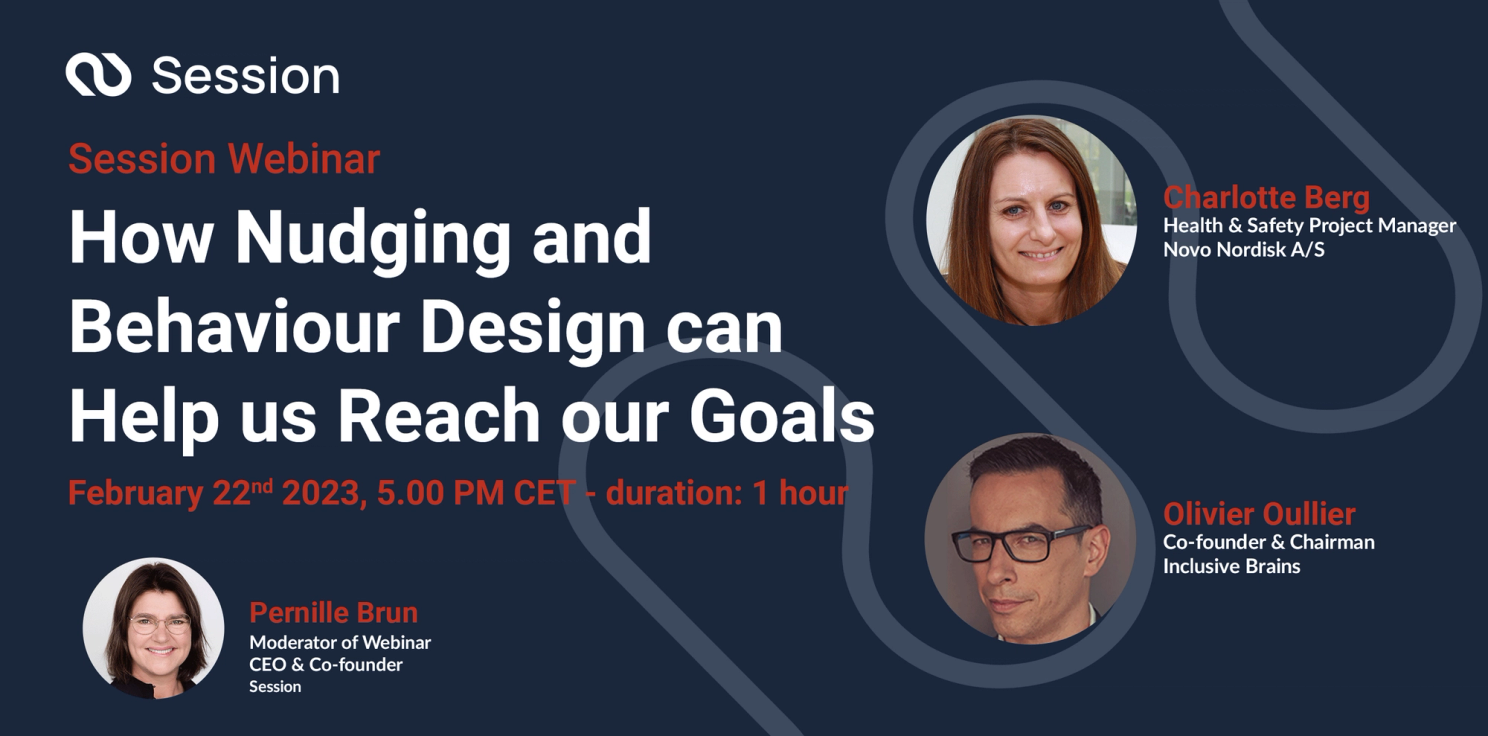Overladt til os selv, er vi mennesker ikke altid gode til at træffe gode beslutninger for os selv - paradoksalt nok. Vi kommer ind imellem til at spise eller drikke for meget, dyrke for lidt motion, sove for lidt eller kaste os ud i dopamin-fremmende adfærd (fx. at arbejde igennem en hel nat, eller at bringe os selv på kanten af, hvad der er sikkert). Den slags kan måske på kort sigt få os til at føle os godt tilpas, men på lang sigt er den slags adfærd ikke god for os. Og alligevel ender mange af os ofte i dem igen og igen, endda mod bedre vidende! Hvorfor? Og hvad nu hvis der var en måde hvorpå vi bedre kunne hjælpe os selv til at “gøre det lettere at gøre det rigtige”?
Den gode nyhed er, at det er der faktisk. Måden eller metoden kaldes adfærdsdesign.
I denne artikel får du indsigt i hvad adfærdsdesign er, og hvordan HR og ledelse kan bruge adfærdsdesign til at introducere og implementere organisatoriske forandringer og andre tiltag på en måde, der positivt påvirker medarbejderne og virksomheden som helhed.

Hvad er Behavioral Design - og hvorfor har vi brug for det?
Adfærds Design (AD) er en systematisk tilgang til at anvende adfærdsmæssige indsigter til at designe processer, der fokuserer på at hjælper mennesker med at “gøre det rigtige” og/eller “gå i den rigtige retning”. AD udspringer af teorier om samt forskning i menneskers adfærd, samt hvad der påvirker mennesker til at handle på bestemte måder. Adfærdsdesign har hidtil mest været brugt indenfor sundheds- og sikkerheds området samt til kriminalitetsforebyggelse. I dag begynder området at nå ud til organisationer og virksomheder globalt, til gavn for bl.a. måden man designer lederudviklingsforløb samt forandringsprocesser.
Organisatoriske forandringsprocesser mislykkes ofte, fordi de ikke tager hensyn til den menneskelige faktor. Når vi implementerer eller igangsætter forandringer, skal vi tage i betragtning, at mennesker ikke er så rationelle eller logiske, som vi måske tror (eller håber), de er. I stedet træffer mennesker beslutninger baseret på følelser, på hvor sultne vi er, eller baseret på "hvad der lige er sket" - meget ofte uden at vi selv ved det. Vi bliver hele tiden ubevidst påvirket af ting, der foregår omkring os, og hjernen forsøger hele tiden at økonomisere med de ressourcer og den information, den har til rådighed. Det fører til, at den indimellem drager forhastede konklusioner baseret på generaliseringer, normaliseringer og “typiskheder”. Dette kaldes med et fint ord for "hjerneheuristik", hvor hjernen altså kategoriserer ting for os, så vi kan lave vurderinger og træffe beslutninger nemt og hurtigt.
Disse kategoriseringer kan, hvis de ikke kontrolleres, være fulde af fejl og fejlvurderinger, og føre til at vi f.eks. drager en forhastet konklusion om hvilken kandidat, der vil være den bedste ud af en pulje af ansøgere, uden at vi undervejs bemærker, at den, vi vælger, er den, der ligner os mest (en typisk "in-and-out-group fejl" baseret på en - måske ubevidst - lighedsfordom). Eller føre til, at vi designer en forandringsproces, der er alt for ambitiøs og mangler en realistisk tidslinje - fordi vi falder i fælden om "overdreven tillid til egen formåen”.
Forandringsprocesser bør derfor designes på en måde, hvor vi bevidst tager højde for de faldgruber vi mennesker ofte falder i med at være urealistiske i forhold til hvad vi kan nå, urealistiske i forhold til hvor begejstrede folk vil være over tid og urealistiske overfor hvor let målgruppen vil have ved at forstå vores budskaber i et excel-ark. HR spiller en altafgørende rolle i forhold til at sikre, at der tages højde for de menneskelige faktorer i de processer, som vi designer i organisationen, og som vi naturligvis ønsker, at mennesker skal følge.
At ændre på ting (og mennesker), der er svære at ændre…
Forandringsprocesser gennemføres bedst, hvis HR og ledelsen gør det meget nemt, enkelt, sjovt, attraktivt og ubesværet for medarbejderne at handle på den nye måde, der efterspørges i forhold til at få en forandring gennemført. I bogen Switch: Sådan ændrer du ting, der er svære at ændre (skrevet af Chip & Dan Heath) er mange af de grundlæggende principper for adfærdsdesign beskrevet. Jeg vil varmt anbefale HR og ledere at læse denne bog, der giver et godt og grundigt indblik i principperne bag adfærdsdesign i en organisatorisk ramme, samt hvordan man med succes kan drive forandringer i en organisatorisk sammenhæng. I dette afsnit gennemgås nogle af hovedpointerne.
I bogen indleder forfatterne med at stille spørgsmålet: “Hvorfor er det så svært at lave langsigtede ændringer i vores virksomheder, samfund og personlige liv?” For at forklare dette bruger forfatterne analogen med en elefant og en rytter af elefanten:
- Rytteren: Dette er analogen til menneskets rationelle side. Rytteren sætter retning og planlægger. Den laver regneark, analyserer og udstikker langsigtede visioner. Den motiveres af argumenter og logik, tal og fakta.
- Elefanten: Dette er analogen til vores følelsesmæssige side som mennesker. Den side reagerer instinktivt og reagerer stærkt på smerte og nydelse. Elefanten vil gå derhen, hvor det er sjovt eller rart at gå hen, og hvis den er bange, vil den stå stille eller løbe i en tilfældig retning. Uanset hvor hårdt man taler til elefanten, vil den gå sin egen vej, når den er fanget af sine følelser - ligesom os mennesker.
Rytterens svaghed er tilbøjeligheden til at overanalysere og overtænke ting. Når Rytteren gør dette, mangler elefanten retning og motivation – og forandring bliver svær. Ændring er kun mulig, når både rytteren og elefanten arbejder sammen:
"Hvis du vil ændre tingene, er du nødt til at appellere til begge sider. Rytteren sørger for planlægningen og retningen, og elefanten giver motivationen og energien."
Den gode nyhed er, at du kan leve i harmoni med både elefanten og rytteren, hvis du balancerer de to sider. For at gøre dette, og for at gøre forandring lettere, skal du gøre følgende:
- Diriger rytteren. Giv krystalklar retning. "Det, der ligner modstand, er ofte en mangel på klarhed." Med andre ord, hvis folk går i den forkerte retning eller træffer de forkerte beslutninger på daglig basis, hvilken slags information mangler de så? Har du tydeligt forklaret, hvad det er, du vil have dem til at gøre – og hvorfor? Jo mere direkte og tydelig du kan være, jo bedre. Gør det visuelt. Gør det nemt at SE, hvad der skal gøres – og hvorfor.
- Motiver elefanten. Engager den følelsesmæssige side. Som forfatterne af Switch udtrykker det,"Det, der ligner dovenskab, er ofte udmattelse." Du skal engagere dine medarbejdere på en måde, der appellerer til dem, gør at de kan bringe deres styrker i spil og bygger videre på det, de kender til og føler sig godt tilpas med. Du skal hjælpe dem med at have det sjovt, mens de arbejder. Dette vil gøre det lettere for dig at engagere og motivere folk til at bevæge sig i den retning, som du ønsker, at de skal gå.
- Vis vejen. Skab betingelserne for, at både rytteren og elefanten kan udmærke sig."Det , der ligner et menneske-problem, er ofte et situations-problem." I en arbejdssammenhæng betyder det, at man skal se på, hvorfor folk tager den vej, de går. Meget ofte er det fordi det er den nemmeste, eneste synlige måde eller hvad de altid har gjort. For at hjælpe folk med at ændre sig, gøre det svært at gå eller gøre ting "på den gamle måde", gøre det nemt at gøre "det nye". Og så samle folkemængderne, så folk kan følge hinandens eksempler.
Ved at følge ovenstående råd er du mere sikker på, at nå i mål med dine forandringstiltag. Du “nudger” folk til at gøre det rigtige.
Flere praktiske trin til at hjælpe folk med at “gøre det rigtige”
Lad os se på hvilke andre praktiske skridt, I kan tage, for bedst muligt at drive forandringer og hjælpe medarbejderne med at “gøre det rigtige”:
- Sæt farten ned og tænk jer om: Når I tager beslutninger, starter noget nyt eller ændrer tingene - så sænk farten. Planlæg grundigt. Hvis I haster tingene igennem i en organisatorisk sammenhæng, er sandsynligheden for, at I træffer de forkerte beslutninger meget højere. Sørg for at indsamle input, udfordre de indledende antagelser og synspunkter, rådføre jer med eksperter og lad være med at stole på jeres mavefornemmelse - den er ofte forkert, især hvis I er pressede eller stressede.
- Gør “hvorfor” klart: Hvis vi ved, hvorfor vi gør, hvad vi gør (eller forventes at gøre), bliver forandring lettere. I kan gøre det klart med tal, billeder, videoer, udsagn, regneark – hvad end der skal til, for at argumentere for, hvorfor forandring er nødvendig, hvordan det ser ud, og hvad der skal til. Husk, billeder taler ofte højere end ord.
- Fremhæv fremskridt: Mennesker elsker følelsen af fremskridt - derfor har civilisationen fornyet sig og gjort ekstraordinære ting og vil fortsætte med at gøre det. Derfor er det en god idé at fremhæve og kaste lys på fremskridt, uanset hvor store eller små de måtte være. I kan f.eks oprette en Slack-kanal, hvor I deler positive nyheder om fremdrift og resultater, eller dele historier om ting, der går i den rigtige retning, på afdelingsmøder. Som forfatterne af Switch udtrykker det:
"I situationer, hvor mange på et team er begyndt at “gøre det rigtige”, er det en fordel at fremhæve det for de andre i teamet. For eksempel, hvis 80 procent af ens team indsender timesedler til tiden, skal man sørge for, at de andre 20 procent kender gruppenormen. Disse personer vil næsten helt sikkert af sig selv derefter begynde at “gøre det rigtige”. Men hvis kun 10 procent af ens team indsender timesedler til tiden, vil offentliggørelse af disse resultater skade, ikke hjælpe.”
- Opsæt klare milepæle: Den menneskelige hjerne elsker mønstre og klare mål. Det at lave og have konkrete milepæle er en integreret del af adfærdsdesign, da det skaber en følelse af præstation, når man når målene, og etablerer en proaktiv plan for den fremtid, vi stræber efter. Det gør det også nemmere at kommunikere fremskridt til interne og eksterne interessenter og at holde folk ansvarlige, når man har klare milepæle og mål.
- Fokuser på det essentielle: Start ikke for meget eller fyld folks kalendere op med for mange ting. Mindre er faktisk mere. Den menneskelige hjerne kan ikke tage for meget information ind og kan heller ikke følge for mange stier på samme tid. Derfor - hvis du vil have forandring til at ske, så sæt mindre igang. Mind også folk om, hvad vi bliver ved med at gøre/beholder. Vi ændrer noget, men ikke alt. Normalt beholder man 80 % og ændrer 20 % – men det glemmer vi ofte at kommunikere i forandringsprocesser.
- Gør det let: Adfærdsdesign og nudging handler i sin essens om dette princip med at gøre det let at gøre det rigtige.... At fjerne forhindringer, at hjælpe folk med at gøre de rigtige ting og at sætte blokeringer i, hvilket gør det svært for folk at gøre de forkerte ting. Ved at forme stien, vise vejen og vise den rigtige adfærd, gør man det nemt at følge eksemplerne og den nye retning.
- Gør det socialt: Vi mennesker er sociale væsner. Derfor er det en god idé, at “samle flokken” og indarbejde sociale aktiviteter, der gør det sjovt og socialt at tage del i forandringen. Indkald flokken og gør det attraktivt at gøre det nye - og husk at fremhæve pionererne undervejs (rollemodellerne, lederene, influencers, ambassadørerne, de ægte kulturbærere) og få deres input til, hvordan man kan få alle med .
Når vi ser det - sker det: Husk at måle dine adfærdsdesign-interventioner
En af de vidunderlige aspekter ved den menneskelige adfærd er, at det kan måles, om og hvordan folk reagerer på de adfærdsbaserede designprogrammer. Enhver mangel på handling kan tolkes som et signal om, at retningen ikke har været klar nok, eller at medarbejderne ikke har haft de rette betingelser for at forblive motiverede, eller at deres ansvarlighed eller evner skal forbedres. HR og ledelse bør altid holde øje med succes for igangsatte programmer og initiativer.
Konklusion
Adfærdsdesign er en afprøvet metode, som HR og ledelse med succes kan implementere for at øge sandsynligheden for, at forandringsinitiativer lykkes. Hvis du gerne vil lære mere om adfærdsdesign, kan du med fordel se vores webinar ”Hvordan Nudging og adfærdsdesign kan hjælpe os med at nå vores mål på arbejdspladsen”, hvor et panel af eksperter diskuterer emnet mere i dybden.












